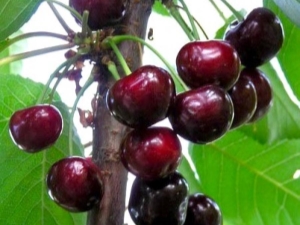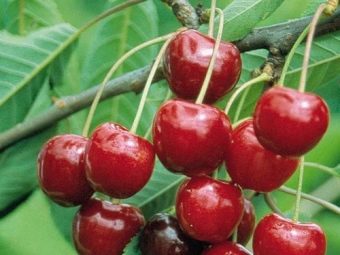Sweet Cherry "Melitopol": characteristics of the variety and secrets of cultivation

Sweet cherry is not only tasty, but also very useful berry. It contains a large amount of nutrients, vitamins and trace elements, including zinc, copper, cobalt, manganese.Sweet cherry "Melitopol" is one of the most popular varieties of culture, which is characterized by dark rich color of berries and amazing taste. In addition, the tree is unpretentious in the care and is resistant to the negative effects of external factors.
History of origin
The culture was bred at the institute of irrigated gardening in the Ukrainian city of Melitopol by free pollination of the variety “French black”. In this region, relatively warm winters with little rainfall and rather dry summers.
Experts recommend growing cherries in the North Caucasus region, as its climate is considered the most favorable.
Black "Melitopol" sweet cherry was introduced into the State Register in 1974. She became the main pride of the city. Later, 2 more varieties of berries were bred - early and red, but still the championship was left for black.
Description
"Melitopol" sweet cherry belongs to the medium early variety. The tree begins to bloom at the end of April, and the berries ripen in the second half of June. Their main advantages are high taste and product quality. But it should also be noted resistance to moniliosis and good sweet cherry transportability, because due to the dense skins during transportation, the berries retain their integrity.
The disadvantages include the fact that the tree does not enter the fruiting phase without pollination. This will help the "relatives" of the following varieties: "Resort", "Bigarro Oratovsky" "Franz Joseph", "Surprise" and "Black Diver". Grafted sweet cherry begins to yield only in the fourth year, and with each season its volume will gradually increase. Another negative quality of "Melitopol" is the instability to low temperature, so it should not be grown in the northern regions. Otherwise, yields may be halved due to the death of flower buds or pistils.
The tree of this variety grows quite quickly, and in adulthood it acquires large dimensions. The crown is thick, broad, rounded in shape, with slightly raised branches. Bark of trunk and skeletal branches of gray-brown color. Cherry has a good ability to form new shoots. As a rule, they are straight and painted gray with a green or yellow shade.
The buds of the “Melitopol” cherries are oval in shape and rather large in size - they can be up to 7 mm long. The leaves are large, wide, drop-shaped, with serrated edges. The scape is massive, up to 4 cm in length.
The berries of this variety are distinguished by a dark, saturated color, a rounded oval shape, a small wide fossa, a barely noticeable abdominal suture and a recess at the base. They are large, arranged on 2-3 pieces, when reaching maturity, each of them weighs 7-8 g. The thickness of the stem is average, the length is not more than 49 mm, it is easily separated from the branch and the fruit, without isolating the juice. The skin of the berries is shiny, thin, but at the same time dense, and is easily separated from the pulp. A large number of barely visible subcutaneous spots, painted in gray. The flesh is juicy, dense, sweet to taste with a little sourness. The bone is round, small, easily separable. Unfinished berries have a bitter taste.
Landing rules
For breeding sweet cherry "Melitopol" use saplings of two types - with a closed and open root system. They must be placed in a well-lit area in direct sunlight. For the possibility of cross-pollination at a distance of about 50 m, other varieties of cherries or sweet cherries must grow. And it is important that their flowering period coincides with the "Melitopol". The soil should be fertile, light, loamy or sandy, with good permeability.
If the area is sandy, peaty or clayey, it must be fertilized with humus or compost. Dolomite flour should be introduced into the land with high acidity. In the autumn planting, superphosphate is used, and in the spring - a nitroammophoska.
For planting, they dig a hole 0.6 m deep and 0.8 m in diameter; they prepare a nutritious soil mixture consisting of fertilizers and top soil. Before placing a seedling in a pit, its roots must be placed in a container with water for several hours. The trunk is cut at a height of 0.6 m, while the cut must be green, if it is brown, then the plant should be cut to the level of healthy wood.
When placing a seedling in a pit, it is necessary to ensure that the root neck and soil are at the same level, and the graft is about 3 cm higher. To support the trees, a peg is installed in the pit, after which it is covered with prepared soil, slightly tamped and a small hole is made with watering boards. The sweet cherry planting is completed with abundant watering and mulching using grass, hay or dry soil.
Care features
The young tree needs regular watering, especially in dry weather. It is important to ensure that the earth always remains wet. For 1 m2 it is necessary to spend 2 buckets of water, while pouring the whole area under the crown of cherries, since its circumference is proportional to the root system. During budding, during the growth of the ovaries and in the fall, before the onset of frost, watering is combined with the subcortex. For example, urea is used in spring, and potassium salt and superphosphate are used in autumn.
The height of an adult "Melitopol" sweet cherry can reach 7 m, which complicates harvesting. Moreover, over time, the fruits cease to grow on the lower branches and go up. Correct the situation will help correct pruning, thanks to which the crown will gradually take the form of a Spanish bush, consisting of several tiers. This procedure will allow to get rid of unnecessary branches, to achieve a uniform distribution of the crop and simplify its collection, since the height of cherries will decrease to 3 m. 78 kg of cherries can be collected from a single tree aged 16 years and over.
On how to properly plant and care for cherries, see the following video.


























